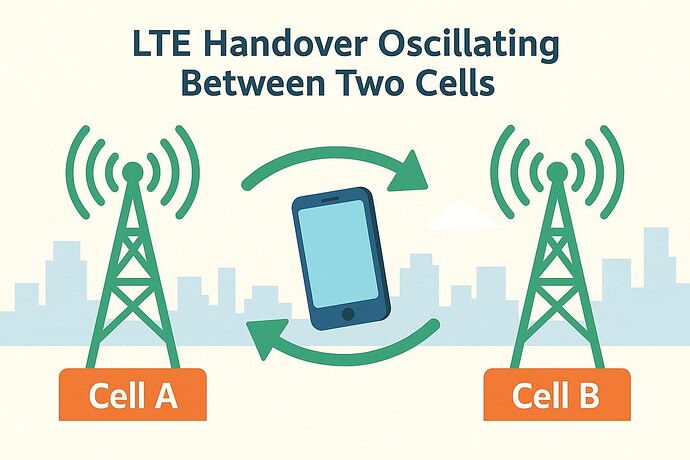What’s the Technical Problem?
In LTE mobility, the UE (user equipment) constantly measures signal conditions (RSRP/RSRQ) of the serving cell and neighboring cells. If a neighbor cell becomes better, the UE may trigger a handover , but what if the difference is temporary or marginal?
That’s when ping-pong handovers occur - rapid back-and-forth switching between two cells, which creates:
![]() Increased signaling overhead
Increased signaling overhead
![]() Faster battery drain
Faster battery drain
![]() Call drops or interrupted sessions
Call drops or interrupted sessions
![]() Poor KPIs like high HOF (handover failure) or RLF (radio link failure)
Poor KPIs like high HOF (handover failure) or RLF (radio link failure)
![]() LTE Theory: How It Avoids Ping-Pong
LTE Theory: How It Avoids Ping-Pong
LTE standards (3GPP) introduced smart mechanisms to stabilize handover decisions, particularly for Event A3, which compares neighbor vs serving cell.
Here are the key components:
![]() 1. Hysteresis (Q_hyst)
1. Hysteresis (Q_hyst)
A positive offset (e.g., 3 dB) added to the serving cell RSRP so that the neighbor must be significantly better.
![]() Prevents handover unless the improvement is real and sustainable.
Prevents handover unless the improvement is real and sustainable.
![]() 2. Time-To-Trigger (TTT)
2. Time-To-Trigger (TTT)
A timer (e.g., 320 ms to 512 ms) that must expire while conditions remain valid before triggering a measurement report.
![]() Helps avoid triggering for brief signal spikes.
Helps avoid triggering for brief signal spikes.
![]() 3. Filtering (Layer 3)
3. Filtering (Layer 3)
Applies moving average filters (e.g., filter coefficient 5) to smooth out fast fading effects in RSRP/RSRQ readings.
![]() Reduces short-term signal noise that might cause false handovers.
Reduces short-term signal noise that might cause false handovers.
Here’s a graph that visualizes RSRP trends for Serving and Neighbor Cells along with the A3 event triggering logic, including:
![]() Serving Cell RSRP (blue line)
Serving Cell RSRP (blue line)
![]() Neighbor Cell RSRP (orange line)
Neighbor Cell RSRP (orange line)
![]() Handover Trigger Zone (green shaded area) where the neighbor RSRP exceeds the serving cell RSRP by an offset (e.g., 3 dB)
Handover Trigger Zone (green shaded area) where the neighbor RSRP exceeds the serving cell RSRP by an offset (e.g., 3 dB)
![]() Dashed green line = “Serving RSRP + Offset” to indicate the handover threshold
Dashed green line = “Serving RSRP + Offset” to indicate the handover threshold
![]() Visual Elements:
Visual Elements:
Two LTE towers (Cell A and Cell B)
A phone oscillating rapidly (Without Hysteresis/TTT)
A calm, stable handover only after sustained improvement (With Hysteresis + TTT)
![]() Optimization Tip for Engineers:
Optimization Tip for Engineers:
In urban areas with dense cell grids, set a higher TTT + moderate hysteresis (e.g., 320ms + 3dB).
On highways, consider slightly lower TTT to react faster to degradation.
LinkedIn: ![]()

